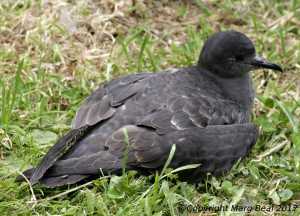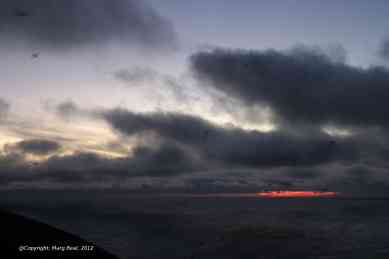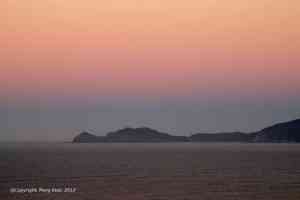Puffinus tenuirostris, common name Short-tailed Shearwater.
It is thought that Maatsuyker Island is home to approximately 800,000 breeding pairs of Short-tailed Shear-waters, or muttonbirds, between late September and April. It is one of the largest colonies in the southern hemisphere. Because the island is free of many predators – no snakes, cats, rats or foxes – they have successfully made the island their own, with burrows dug into the guano-rich soil everywhere except for the mown tracks and rocky cliffs.
 The female lays an egg in the nest in November or December and the chick hatches in January. The adult birds leave the island before sunrise to spend the day at sea finding food (krill). Then they return in the evening, half an hour after sunset.
The female lays an egg in the nest in November or December and the chick hatches in January. The adult birds leave the island before sunrise to spend the day at sea finding food (krill). Then they return in the evening, half an hour after sunset.
A commitment to Tas Parks before the residency was to walk -only- on the designated tracks. Stepping even a short distance off the tracks is likely to collapse a burrow. I have read that each pair of birds mates for life and uses the same burrow each year.
Many burrows are in the soil under the canopy of tea-trees and other tall shrubs and trees. Often when the birds return to their burrow they have to crash through the branches, sometimes resulting in casualties. In the OH&S briefing prior to arriving on the island, being skewered by a landing muttonbird was listed as one of the potential hazards.
Muttonbirds that die become food for the Forest Raven, Corvus tasmanicus, which also feeds on accessible eggs. The “graveyard” near the top of the Summit track is strewn with bird carcasses.
Maatsuyker Island Diary – Thursday 2nd Feb – Day 60
Near the end of the stay, the alarm is set for 3:45am in order to take up a position before the muttonbirds swarm over the tracks to use as their runway. For a few minutes, I lie in bed under the open window, watching the stars and feeling the cold air on my face. After dressing warmly in thermals, fleece pants and jacket, gloves, socks and rubber boots, we set out with cameras and torches. But as soon as we step outside into the pitch dark, we are overcome with awe at the sight of the still, clear star-filled sky.
There are several good vantage points on the island for watching the pre-sunrise take-off, and the trampled grass indicates the highways preferred by the birds. With torches to light the way, we climb up the steep Summit track behind Q3, passing one or two waddling muttonbirds on the way. The path is a sheltered grove of overhanging tea-tree, creating a tunnel that protects from the weather. As we emerge at the chosen viewing spot, on the edge of a steep cliff overlooking Macquarie Slopes, my torch-light picks up streaks which I suddenly realise must be rain. It was calm and the sky clear and starry when we left (Q2) but stepping out onto the exposed cliff-top, the rain stings our faces and the southerly wind makes our fleece clothing seem flimsy. The noise of the birds squawking competes with the howling wind. 
The birds take to the skies, some of them stepping over our feet before launching themselves from the rocks on the edge of the cliff. So clumsy on the ground, they are graceful in the air. In the half-light, the thousands of birds look like swarms of mosquitoes.
By 6am it is silent; the birds are gone for the day and the storm has passed. The dawn sky is pink and blue. Time to head home for breakfast. 
